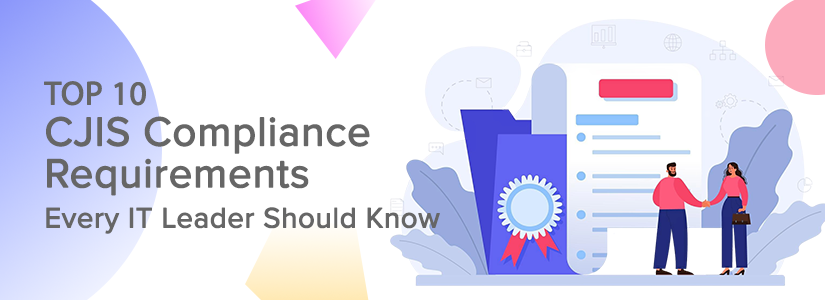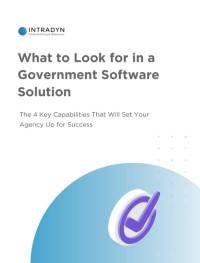Top 10 CJIS Compliance Requirements Every IT Leader Should Know

What municipal IT teams need to implement now—and how modern archiving helps you get there.
Why Understanding CJIS Requirements Matters More Than Ever
Every day, your agency manages sensitive information: arrest records, digital evidence, suspect communications, internal case notes. Whether that information lives in an inbox, a text message, or a social media comment thread—if it qualifies as Criminal Justice Information (CJI), it falls under the FBI’s CJIS Security Policy.
For IT leaders, this isn’t just a policy issue—it’s a systems and risk management challenge. Non-compliance can lead to audit failures, loss of access to CJIS systems, or even legal consequences in civil cases.
This guide walks through the 10 most critical CJIS compliance requirements, prioritized by what your team can take action on right now—especially if you’re evaluating communication archiving tools. Each section explains what the policy means, why it matters, and how the right platform can help.
1. Audit and Accountability
Track every access, export, and action across your systems—automatically.
CJIS requires all activity involving CJI to be logged and retained for at least 365 days. That includes user logins, file access, message exports, admin actions, and deletions.
Why it matters:
Your audit logs are your trail of truth. In a breach investigation, you must show who accessed what, when, and how. Without this, you can’t prove compliance—or defend your agency.
How Intradyn helps:
Intradyn automatically creates immutable, exportable audit logs for every archived message type (email, text, iMessage, social media). Admins can review access histories in seconds.
2. Media Protection
Protect stored CJI on all devices and systems—no exceptions.
CJIS requires that any device or system that stores CJI—whether a server, backup drive, cloud platform, or mobile phone—must use FIPS 140-2 encryption to protect that data at rest.
Why it matters:
An unencrypted hard drive or lost phone containing CJI is a breach—period. Agencies must assume any physical loss equals potential exposure.
How Intradyn helps:
All data in Intradyn’s platform—whether cloud-hosted or deployed on-prem—is encrypted using FIPS 140-2 validated protocols, ensuring media protection across storage tiers.
3. Access Control
Control who can access what—and remove access immediately when roles change.
CJIS mandates role-based access controls (RBAC) and enforces the principle of least privilege. Access must be tied to job functions and revoked the moment someone is reassigned or leaves.
Why it matters:
Inactive user accounts, broad permissions, or shared logins are common compliance red flags—and real security threats.
How Intradyn helps:
Intradyn gives administrators fine-grained control over user roles—with instant revocation options.
4. Identification and Authentication
Confirm every login—especially from mobile or remote users.
CJIS requires Advanced Authentication (AA) for remote access, including multi-factor authentication (MFA), password strength, lockout policies, and session expiration.
Why it matters:
Stolen credentials are one of the top ways attackers breach systems. Strong authentication significantly lowers that risk.
How Intradyn helps:
Intradyn supports MFA, strong password policies, and configurable session controls to ensure CJI stays protected—even on mobile devices or remote logins.
5. Security Awareness Training
Train every employee with CJI access—early and often.
CJIS requires annual security awareness training for all personnel who interact with systems storing or accessing CJI.
Why it matters:
Most breaches aren’t technical—they’re human. Phishing, improper handling, or accidental exposure can all trigger violations.
What to do:
Pair automated security training with real-world scenarios that reflect how your team communicates (e.g., email, text, mobile apps). Track completion across roles and departments.
6. Incident Response Planning
Have a response plan—and test it before an incident happens.
CJIS requires every agency to maintain a documented Incident Response Plan (IRP). The plan must cover how you identify, contain, document, report, and recover from a breach.
Why it matters:
When something goes wrong, you need to act fast—and prove that you followed procedure. If you can’t show a tested IRP, you’re out of compliance.
Pro tip:
Run tabletop exercises at least once a year. Simulate common events like credential compromise, a lost device, or a ransomware attack.
7. Configuration Management
Secure every system and document every change.
CJIS mandates configuration management controls that track system changes, update software regularly, disable unused services, and log all administrative actions.
Why it matters:
Outdated software, forgotten open ports, and unknown services create vulnerabilities. One unpatched system can expose everything.
Best practice:
Maintain a configuration baseline and conduct quarterly system reviews. Use change logs to document who made what adjustment and why.
8. Personnel Security
Vet everyone—and deprovision them immediately if they leave.
CJIS requires background checks for all personnel with access to CJI, including contractors. It also requires immediate access revocation upon role change, resignation, or termination.
Why it matters:
Old user accounts are one of the most common audit violations—and security threats. If someone leaves and still has access, you’re exposed.
What to do:
Integrate offboarding workflows with your user management system. Review active accounts quarterly and ensure every user has a current background check on file.
9. Physical Protection
Secure the physical spaces that house your systems and staff.
CJIS applies to both digital and physical environments. Servers, backup systems, evidence lockers, and offices that access CJI must have controlled physical access, surveillance, and visitor logging.
Why it matters:
If someone can walk into your server room without authorization—or take a laptop from a desk—you’re not compliant, regardless of digital safeguards.
Recommendations:
Use badge readers or biometric locks. Keep physical logs or use an access system. Escort visitors and limit non-essential access to CJIS-secured areas.
10. System & Communications Protection
Protect CJI as it moves across networks—internally and externally.
CJIS requires agencies to secure CJI in transit using TLS encryption, isolate secure systems from public networks, and implement network-level protections like firewalls and intrusion detection.
Why it matters:
Even if your data is secure at rest, it can be exposed during transmission. Wireless networks, public internet access, or cross-departmental transfers all carry risk.
How Intradyn helps:
Intradyn uses TLS and HTTPS for encrypted transmission of archived data. It can also be deployed within segmented networks, giving your IT team control over firewall rules and traffic paths.
Map Policy to Tools—and Act Proactively
CJIS compliance isn’t just a checklist—it’s an ongoing commitment to security, transparency, and accountability. The good news? You don’t have to do it alone.
With solutions like Intradyn, your agency can:
- Archive and protect every communication channel
- Generate instant audit logs for compliance review
- Control access and permissions with confidence
- Encrypt everything—automatically
- Get ahead of audits and investigations
Ready to Build a CJIS-Compliant Archiving Strategy? Let’s help your agency secure every message, across every device and channel. Request a complimentary demo.

